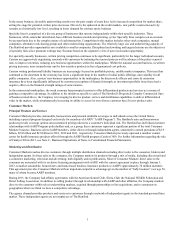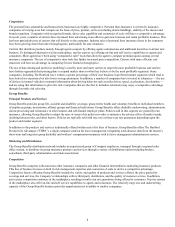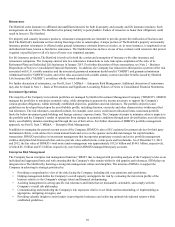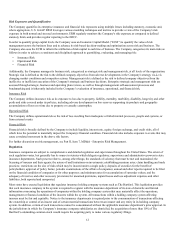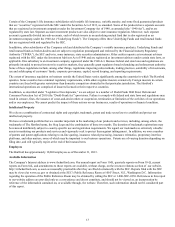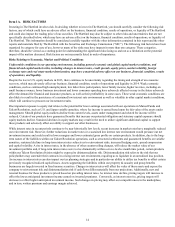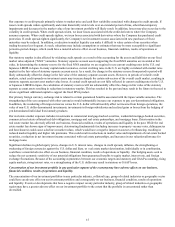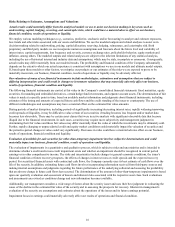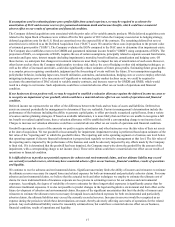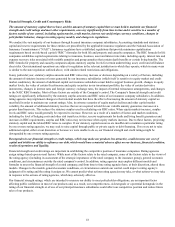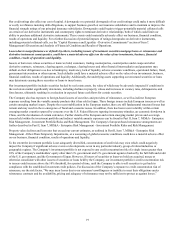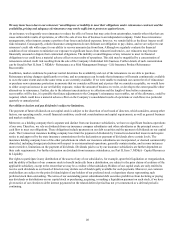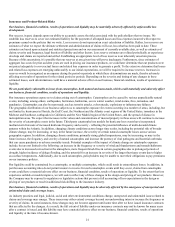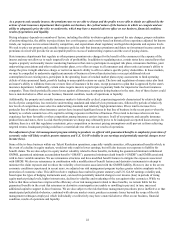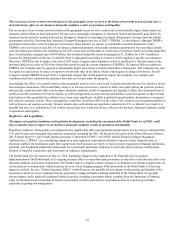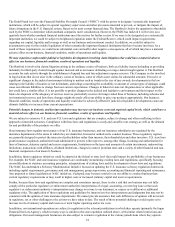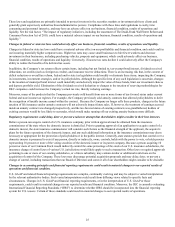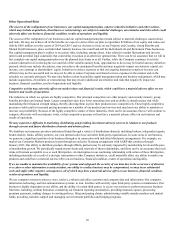The Hartford 2013 Annual Report Download - page 17
Download and view the complete annual report
Please find page 17 of the 2013 The Hartford annual report below. You can navigate through the pages in the report by either clicking on the pages listed below, or by using the keyword search tool below to find specific information within the annual report.17
If assumptions used in estimating future gross profits differ from actual experience, we may be required to accelerate the
amortization of DAC and increase reserves for guaranteed minimum death and income benefits, which could have a material
adverse effect on our results of operations and financial condition.
The Company deferred acquisition costs associated with the prior sales of its variable annuity products. While deferred acquisition costs
related to the Japan block of business were written off in the first quarter of 2013 when the Company executed on its hedging strategy,
deferred acquisition costs for the U.S. block are amortized over the expected life of the contracts. The remaining deferred but not yet
amortized cost is referred to as the Deferred Acquisition Cost (“DAC”) asset. We amortize these costs in proportion to the present value
of estimated gross profits (“EGPs”). The Company evaluates the EGPs compared to the DAC asset to determine if an impairment exists.
The Company also establishes reserves for GMDB and guaranteed minimum income benefit ("GMIB") using components of EGPs. The
projection of EGPs, or components of EGPs, requires the use of certain assumptions, principally related to separate account fund returns,
surrender and lapse rates, interest margin (including impairments), mortality, benefit utilization, annuitization and hedging costs. Of
these factors, we anticipate that changes in investment returns are most likely to impact the rate of amortization of such costs. However,
other factors such as those the Company might employ to reduce risk, such as the cost of hedging or other risk mitigating techniques, as
well as the effect of increased surrenders, could also significantly reduce estimates of future gross profits. Estimating future gross profits
is a complex process requiring considerable judgment and the forecasting of events well into the future. If our assumptions regarding
policyholder behavior, including lapse rates, benefit utilization, surrenders, and annuitization, hedging costs or costs to employ other risk
mitigating techniques prove to be inaccurate or if significant or sustained equity market declines occur, we could be required to
accelerate the amortization of DAC related to variable annuity contracts, and increase reserves for GMDB and GMIB, which would
result in a charge to net income. Such adjustments could have a material adverse effect on our results of operations and financial
condition.
If our businesses do not perform well, we may be required to establish a valuation allowance against the deferred income tax asset or
to recognize an impairment of our goodwill, which could have a material adverse effect on our results of operations and financial
condition.
Deferred income tax represents the tax effect of the differences between the book and tax basis of assets and liabilities. Deferred tax
assets are assessed periodically by management to determine if they are realizable. Factors in management's determination include the
performance of the business including the ability to generate capital gains, to offset previously recognized capital losses, from a variety
of sources and tax planning strategies. If based on available information, it is more likely than not that we are unable to recognize a full
tax benefit on realized capital losses, then a valuation allowance will be established with a corresponding charge to net income (loss).
Charges to increase our valuation allowance could have a material adverse effect on our results of operations and financial condition.
Goodwill represents the excess of the amounts we paid to acquire subsidiaries and other businesses over the fair value of their net assets
at the date of acquisition. We test goodwill at least annually for impairment. Impairment testing is performed based upon estimates of the
fair value of the “reporting unit” to which the goodwill relates. The reporting unit is the operating segment or a business one level below
that operating segment if discrete financial information is prepared and regularly reviewed by management at that level. The fair value of
the reporting unit is impacted by the performance of the business and could be adversely impacted by any efforts made by the Company
to limit risk. If it is determined that the goodwill has been impaired, the Company must write down the goodwill by the amount of the
impairment, with a corresponding charge to net income (loss). These write downs could have a material adverse effect on our results of
operations or financial condition.
It is difficult for us to predict our potential exposure for asbestos and environmental claims, and our ultimate liability may exceed
our currently recorded reserves, which may have a material adverse effect on our business, financial condition, results of operations
and liquidity.
We continue to receive asbestos and environmental claims. Significant uncertainty limits the ability of insurers and reinsurers to estimate
the ultimate reserves necessary for unpaid losses and related expenses for both environmental and particularly asbestos claims. For some
asbestos and environmental claims, we believe that the actuarial tools and other techniques we employ to estimate the ultimate cost of
claims for more traditional kinds of insurance exposure are less precise in estimating reserves for our asbestos and environmental
exposures. Accordingly, the degree of variability of reserve estimates for these longer-tailed exposures is significantly greater than for
other more traditional exposures. It is also not possible to predict changes in the legal and legislative environment and their effect on the
future development of asbestos and environmental claims. Because of the significant uncertainties that limit the ability of insurers and
reinsurers to estimate the ultimate reserves necessary for unpaid losses and related expenses for both environmental and particularly
asbestos claims, the ultimate liabilities may exceed the currently recorded reserves. Increases in reserves would be recognized as an
expense during the periods in which these determinations are made, thereby adversely affecting our results of operations for the related
periods. Any such additional liability cannot be reasonably estimated now, but could have a material adverse effect on our business,
financial condition, results of operations and liquidity.


